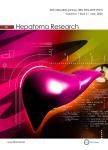Prediction of post-progression survival in patientswith advanced hepatocellular carcinoma treated with sorafenib by using time-dependent changes inclinical characteristics
Prediction of post-progression survival in patientswith advanced hepatocellular carcinoma treated with sorafenib by using time-dependent changes inclinical characteristics作者机构:Department of Hepato-Biliary-Pancreatic SurgeryClinical Research InstituteNational Hospital Organization Kyushu Medical CenterFukuoka 810-8563Japan
出 版 物:《Hepatoma Research》 (肝癌研究(英文版))
年 卷 期:2018年第4卷第3期
页 面:1-8页
学科分类:1002[医学-临床医学] 100214[医学-肿瘤学] 10[医学]
主 题:Contactin-associated protein-2 Isaac neuromuscular hyperexcitability neuromyotonia voltage-gated potassium channel
摘 要:Aim: Sorafenib has been shown to improve time to tumor progression (TTP) and overall survival (OS) in patients with hepatocellular carcinoma (HCC);however, post-progression survival (PPS) has not been well characterized in these patients. This study aimed to evaluate the predictors of PPS by using time-dependent and dynamic changes in radiologic progression patterns, liver function, and performance status (PS) in patients with advanced HCC receiving sorafenib treatment. Methods: We retrospectively analyzed the clinical characteristics of 128 advanced HCC patients with Child-Pugh scores ≤ 7 at the initiation of sorafenib treatment. Results: The median TTP, OS, and PPS were 3.8, 15.6, and 9.9 months, respectively. At the time of confirmation of radiologic progressive disease (PD), a total of 46 (35.6%) patients showed impairments in their PS of ≥ +1 points over time. For the Child-Pugh score, 27 (21.1%) and 26 (10.9%) patients exhibited an impairment of ≥ +1 and ≥ +2 points, respectively. Multivariate analysis identified the following independent predictors of PPS: impairment in the PS score of ≥+1 point [hazard ratio (HR) 1.81, 95% confidence interval (CI) 1.16-2.82], impairment in the Child-Pugh score of ≥ +2 points (HR 3.70, 95% CI 1.68-8.15), radiologic pattern of progression (target lesion growth and emergence of a new lesion) (HR 2.91, 95% CI 1.79-2.91), a TTP 4 months(HR 1.87, 95% CI 1.21-2.91), second-line treatment after radiologic confirmation of PD (HR 0.16, 95% CI 0.08-0.32), and continuous sorafenib treatment after radiologic confirmation of PD (HR 1.76, 95% CI 1.06-3.00). Conclusion: PPS in patients with advanced HCC can be characterized by using time-dependent dynamic changes in clinical parameters.



